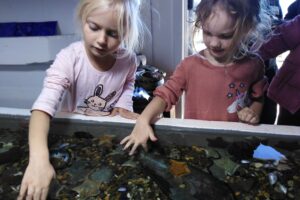Ten year old Megh discovered lots about her local area when her class went out exploring a nearby storm water pond. Here is what she found out.
We went to see a storm water pond to carry out water testing today. I was really excited. My mum was one of the parent helpers for the trip and which made me even happier. It was a fairly long walk from our school, however it was actually lot of fun and good exercise for our legs.
When we reached the pond it really looked a very pretty site. It was very green all around and the grass smelt like hay. There was a lovely little wooden bridge which we had to walk over. We then split ourselves into different groups, as already pre-planned.
Our first task was to test the water quality. Kasey from our group collected water sample from the stream so that we could carry out the pH test and the nitrate content of the water. We poured the water into a small container and dipped the litmus paper in it for about 15-20 seconds. The litmus paper changed its colour as per the pH of water. We compared its colour with a card which showed pH reading for different shades. Generally the pH was in the range of 9-10. Next, we also did the nitrate test of the water sample, using special test strips. The nitrate content in water was about 25 ppm.
After the testing, we were encouraged to look for some small, tiny invertebrates in the stream. And, we indeed found quite a few.
The whole excursion was indeed a lot of fun.
We know that to support a healthy ecosystem the pH of the water has to be in the range in the range 6-8. So, the high pH of above 9 meant that the water in the pond was too alkaline and not good for the fish and other aquatic life in there.

Hydrangea macrophylla Photo by Joanne Bergenwall
Hydrangea is a fascinating flower which changes colour according to the acidity or alkalinity of the soil. Grown in acidic soil (pH below 6), its colour is blue and in alkaline soil (pH above 7) it becomes pink. I like to call it as “litmus” flower, whose colour tells us about the soil chemistry.
Make your own litmus paper using red cabbage (with some adult help)…
1. Boil up some red cabbage in a pan until it’s well cooked.
2. Let as much of the water evaporate as possible so it’s a nice cabbage soup – yum!
3. Find some plain paper and dip it in until it is covered with the soup and leave to dry.
4. Use the paper to test other water around your home. (whilst making sure you’re always safe and have adult supervsion).
If the paper turns red, the water is acidic. If it’s green, it’s alkaline.
Try this website with more ideas about what you can use.







